Advertise Online
–
SEO - Search Engine Optimization - Search Engine Marketing - SEM
– Domains For Sale
– George Washington Bridge Bike Path and Pedestrian Walkway
– Corona Extra Beer Subliminal Advertising
– Outlaw Motorcycle Gangs
– Pet Care
–
The Tunnel Bar
–
La Cosa Nostra
–
Jersey City Free Books
From Historic Roadsides of New Jersey by The Society of Colonial Wars in the State of New Jersey, 1928
Edited by GET NJ, COPYRIGHT 2002
HUDSON COUNTY
This County, organized from the southern portion of
Bergen County in 1840, is the smallest county in the State.
BERGEN
"Village of Bergen" founded 1616 by Dutch
Colonists. Perhaps named from Bergen in Norway. Land
purchased from the Indians 1658-9 by Director General Stuyvesant and Council of the New Netherlands. After the Colony passed into the possession of the English, a charter granted
by Governor Carteret to the town and freeholders of Bergen
provided for a church and free school supported by a tract of
land exempt of tax.
During the Revolution the Americans built a fort near the
center of the village on land belonging to one Newkirk, while
the British built a fort about a mile southeast of Van Vorts
Hill. The battle of Bergen took place July 19, 1780.
Stephen Ball was murdered at Bergen Point by Tory
Refugees September 15, 1781. At the close of the Revolution,
Cornelius Hetfield, leader of the refugees fled to Nova Scotia.
In 1807, on returning to Jersey, he was arrested for the murder
of Ball, but discharged on habeas corpus by Judge Pennington,
who held that he was within the protection of the Treaty of
Peace of 1783.
The Dutch Church at Bergen, organized in 1660, is the
oldest in the State. In 1680 the church was replaced by one
of stone, octagonal in shape. In 1773 this church was removed
and a new one was erected. In 1664 the first public school in
the State was established with Engelbert Stenbuysen, the
church clerk as master.
Points of interest:
- The Sip Manor. Erected 1666 by Claas Ariance Sip,
owned by his male descendants in 1902. Lord Cornwallis
and his staff spent a night here in 1776 and tradition says
hanged three spies on a willow tree in the garden before
leaving next day.
- Appletree House. Academy Street off Bergen Square.
Home of Herman Wagenen who owned it when Washington and Lafayette dined under the great appletree in the
orchard, which was still standing when Lafayette visited
Bergen in 1824.
|
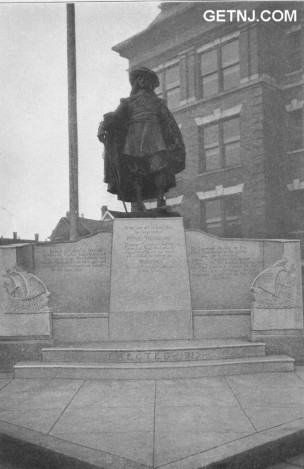 Statue of Peter Stuyvesant, Jersey City
Statue of Peter Stuyvesant, Jersey City
Marking the Site of the Village of Bergen, the First Permanent Settlement in New Jersey
|
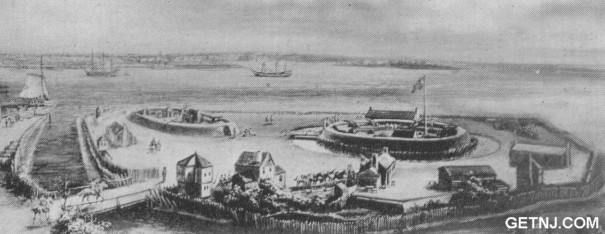 Scene of the Battle of Paulus Hook
Scene of the Battle of Paulus Hook
Now Grand and Greene Streets, Jersey City
JERSEY CITY
In 1630, the patroonship of Pavonia was
created in Michiel Parew of Amsterdam, embracing Hoboken.
He did little to comply with the terms of his grant and the
company bought him out. In 1633 the Company built two
trading posts, one at Communipaw and one at Ahasimus or Jersey City. A third was built at Paulus Hook, named after
Michael Paulusen, the patroon.
Points of interest:
- Grand and Greene Streets. The battle of Paulus Hook
took place here August 19, 1779. The British fort, then
on an island, now in the heart of the City, was at or near
Grand and Greene Streets. Stormed by "Light Horse
Harry" Lee and three hundred men, including Allen
McLane's dismounted dragoons, with a loss of two killed
and three wounded.
- Prospect Hall. End of Essex Street. Home of Col. Richard Varick, for thirty years President of Society of the Cincinnati. Erected 1807 by Major Hunt, mentioned by
Washington Irving in Salmagundi. Varick, one of Washington's Secretaries and Mayor of New York while it was
the national capitol. Lafayette entertained here in 1824.
- The White House. Site at northwest corner Sussex and
Hudson Streets. Owned by Colonel Varick, rented to a
Mrs. Hedden, who here entertained Aaron Burr while he
wrote or arranged his memoirs in 1830.
- Van Vorst House. Wayne Street. Home of Cornelius
Van Vorst. Sold by him to Edge family. Kitchen step
was stone base of the statue of George III, Bowling Green,
New York, which was overturned and melted in 1776.
The stone which prior to becoming step to Van Vorst kitchen, was used to mark grave of Major John Smith of
Royal Highland Regiment is now in New York Historical
Society.
- Prior House. Wayne Street. Quarter of a mile from Van Vorst House. House and mill of
Jacob Prior used by General Mercer, General Greene, and
Lord Stirling. Stopping point of Lee returning from
Paulus Hook.
HOBOKEN
From Hobocan-hackingh "the place of the
tobacco pipe." In 1643 a farm house and brew house were
built north of Hoboken by Aert Van Putten, but town did not
grow. In 1783 John Stevens purchased site of Hoboken for
eighteen thousand three hundred and sixty pounds and put it
on sale in town lots in 1804.
Points of interest:
- Castle Point. Home of Colonel John Stevens. Part of
the confiscated Bayard Estate. House built about 1784.
Stevens workshop in Hoboken where he experimented and
built the Phoenix Steamboat was on or near the site of
Stevens Institute.
- Astor Villa. Corner of Washington and Second Streets.
Home in 1828 of John Jacob Astor. Fitz-Greene Halleck,
the poet, Martin Van Buren, and Washington Irving often
visited Astor here.
WEEHAWKEN
Probably from Awiehawken, name of a
stream.
Places of interest:
- Highwood. Site of home of James Gore King lying between Bulls Ferry Road and River near Stevens Estate.
Two of the King family descended from Rufus King, were
men of note-Chas. King, President of Columbia College
and James Gore King, a banker known as "The Almighty
of Wall Street." Here were entertained many people of
note e.g., Daniel Webster, Nicholas Biddle, Charles
Dickens and wife.
- Dueling ground on King Estate where July 11, 1804 Alexander Hamilton was killed by Burr on the spot where his
son, Philip Hamilton, had been killed. DeWitt Clinton,
Commodore Perry, and others fought here.
|
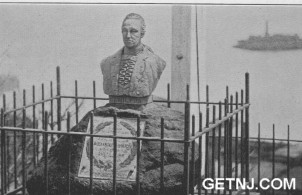 Bust of Alexander Hamilton
Bust of Alexander Hamilton
Marking the Scene of His Duel with Aaron Burr, Weehawken
|
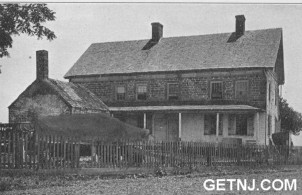 Retirement Hall, Greenville
Retirement Hall, Greenville
|
GREENVILLE or Pamrapaugh
Three miles south of Jersey
City. (now part of Jersey City, editor's note)
Retirement Hall. Built 1760 by Captain Thomas Brown,
one of the chief slave dealers in the Colonies. Brown adhered
to the Colonies. In September, 1781, during a storm, Prince
William Henry, later William IV, took refuge at Retirement
Hall. Passed out of hands of Brown's heirs and became finally
home of Greenville Yacht Club.
|
|
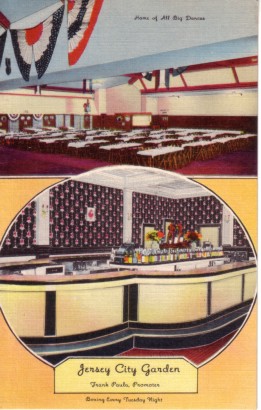 Jersey City Garden Post Card (196 Ogden Ave., original, not mailed) – $4.00
Jersey City Garden Post Card (196 Ogden Ave., original, not mailed) – $4.00
Mail your check to Anthony Olszewski, 297 Griffith St, Jersey City, N.J., 07307
To pay by PayPal, e-mail Anthony.Olszewski@gmail.com
 The Hudson River Is Jersey City's Arena For Water Sports!
The Hudson River Is Jersey City's Arena For Water Sports!

















